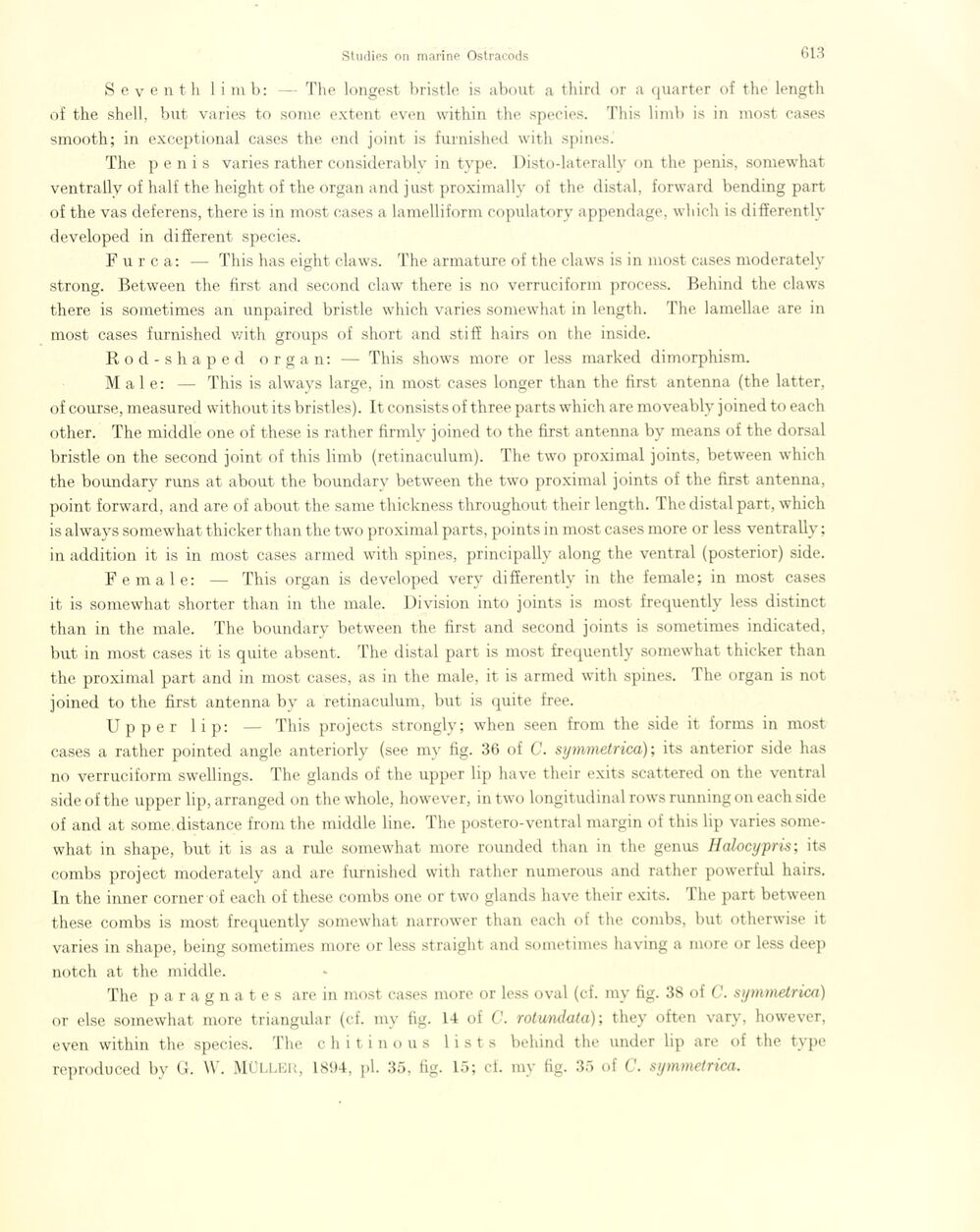
Full resolution (JPEG) - On this page / på denna sida - Sidor ...

<< prev. page << föreg. sida << >> nästa sida >> next page >>
Below is the raw OCR text
from the above scanned image.
Do you see an error? Proofread the page now!
Här nedan syns maskintolkade texten från faksimilbilden ovan.
Ser du något fel? Korrekturläs sidan nu!
This page has never been proofread. / Denna sida har aldrig korrekturlästs.
S e v e n t h 1 i ni b: — The longest bristle is about a third or a quarter of the lengtli
of the shell, but varies to sortie extent even within the species. This limb is in most cases
smooth; in exceptional cases the end joint is furnished with spines.
The penis varies rather considerablv in type. Disto-laterally on the penis, somewhat
ventrally of half the height of the organ and just proximally of the distal, forward bending part
of the vas deferens, there is in most cases a lamelliform copulatory appendage, which is difîerently
developed in different species.
Furca: — This has eight claws. The armature of the claws is in most cases moderately
strong. Between the first and second claw there is no verruciform process. Behind the claws
there is sometimes an unpaired bristle which varies somewhat in length. The lamellae are in
most cases furnished with groups of short and sti ff hairs on the inside.
Rod-shape d organ: — This shows more or less marked dimorphism.
Male: — This is always large, in most cases longer than the first antenna (the latter,
of course, measured without its bristles). It consists of three parts which are moveably joined to each
other. The middle one of these is rather firmly joined to the first antenna by means of the dorsal
bristle on the second joint of this limb (retinaculum). The two proximal joints, between which
the boundary runs at about the boundarv between the two proximal joints of the first antenna,
point forward, and are of about the same thickness throughout their length. The distal part, which
is always somewhat thicker than the two proximal parts, points in most cases more or less ventrally ;
in addition it is in most cases armed with spines, principally along the ventral (posterior) side.
F ema le: — This organ is developed very difîerently in the female; in most cases
it is somewhat shorter than in the male. Division into joints is most frequently less distinct
than in the male. The boundary between the first and second joints is sometimes indicated,
but in most cases it is quite absent. The distal part is most frequently somewhat thicker than
the proximal part and in most cases, as in the male, it is armed with spines. The organ is not
joined to the first antenna by a retinaculum, but is quite free.
Upper lip: — This projects strongly; when seen from the side it forms in most
cases a rather pointed angle anteriorly (see my fig. 36 of C. symmetrica); its anterior side has
no verruciform swellings. The glands of the upper lip have their exits scattered on the ventral
side of the upper lip, arranged on the whole, however, in two longitudinal rows running on each side
of and at some distance from the middle line. The postero-ventral margin of this lip varies
somewhat in shape, but it is as a rule somewhat more rounded than in the genus Halocypris; its
combs project moderately and are furnished with rather numerous and rather powerful hairs.
ln the inner corner of each of these combs one or two glands have their exits. The part between
these combs is most frequently somewhat narrower than each of the combs, but otherwise it
varies in shape, being sometimes more or less straight and sometimes having a more or less deep
notch at the middle.
The paragnates are in most cases more or less oval (cf. my fig. 38 of C. symmetrica)
or else somewhat more triangulär (cf. my fig. 14 of C. rotundata); they often vary, however,
even within the species. The c h i t i n o u s lists behind the under lip are of the type
reproduced by G. W. MÜLLER, 1894, pi. 35, fig. 15; cf. my fig. 35 of C. symmetrica.
<< prev. page << föreg. sida << >> nästa sida >> next page >>